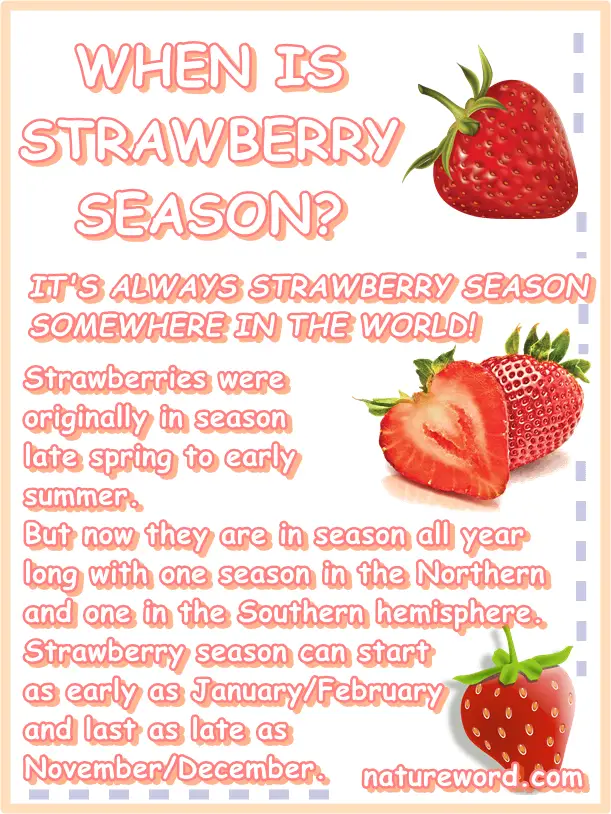Strawberries are in early summer and you can buy them fresh despite it being fall.
In fact, at any point during the year it’s strawberry season somewhere in the world! But when are strawberries in season more exactly? What months are strawberries in season? What dates does strawberry season start and end? How long does strawberry season last? Are strawberries ever out of season?
When are strawberries in season?
Traditionally strawberry season was late spring to early summer. This is also why a great number of strawberry plants are still being referred to as ‘June-bearing’ strawberries, the name marking the original peak harvest season for the berries in the Northern hemisphere.
However, considering they are cultivated in both hemispheres extensively, and the seasons are reversed, there are actually two official seasons for strawberries that meet and overlap.

Are strawberries ever out of season?
As the cultivation of strawberries has extended to include any region that could sustain even the shortest season for the plant, whether it’s commercial cultivation or home garden cultivation, and numerous cultivars have been developed as a result of the increase in popularity of the berries, we now have strawberries available pretty much all year long.
As strawberries are now coming in from lots of different parts of the world, there’s really no off-season.
However, there may a low season which is when the supply may dwindle in some regions, but even then strawberry availability is largely secured by fruits coming in from both warmer regions and cultivation and greenhouses.
We now have strawberries growing across the US and Europe and Asia and Africa and Australia and New Zealand and all of South America. China, of course, has been leading strawberry production in the 2009-2019 period, followed by the US, then Mexico, Turkey, Egypt, Spain, the Republic of Korea, Poland and Japan (source: FAOSTAT).

Strawberries seasonality
Strawberries never really come out of season as they’re pretty much available all year long from different regions of cultivation.
They can even be grown in pots indoors and grow excellently during winter. But since they are reliant on weather conditions for growing, flowering and fruiting, and optimal flavor, there is a seasonality to them.
That is, strawberries taste their best (and are at their healthiest) at certain times of the year when the natural weather conditions from the various regions of cultivation are optimal for plant growth, flowering and fruiting.
This, of course, varies with the region of cultivation and yearly weather variations.
What factors in strawberry seasonality is cultivar type. Some strawberry plants only produce one crop per year. Plants that produce one crop have one harvest season which lasts about 3 weeks.
This is how long it takes for the strawberries to ripen per individual plant. Different plant varieties will being fruiting at different times during the year, hence the continual supply despite there being one crop.
Strawberry plants with one season can be classified into:
- Early season strawberries which includes very early season and early season strawberries
- Midseason strawberries which can further be divided into early midseason and late midseason
- Late season strawberries which includes late season and very late season strawberries
But some strawberry plants will produce two big crops in a year, but also bear fruit in between their two major harvest seasons. These are called everbearing strawberries. Their season lasts longer overall, sometimes for most of the year.
What are everbearing strawberries?
Everbearing strawberries are cultivated varieties of strawberry with a longer fruiting season. By definition, everbearing means a plant that bears fruit throughout its growing season, or produces multiple crops during its growing season.
Strawberries are naturally perennials, that is, plants that live for more than two years, given the right weather conditions. While they don’t produce fruits continually for the duration of the plant’s life, which can easily be over 3 years, some plants do produce more than one crop a year.
These are called ‘everbearing’ strawberries and are cultivated varieties of strawberry that produce two main crops per year, one in late spring or early summer and one in fall. But they also produce fruits in between the two major harvests; however, the summer harvest is poorer.
Strawberry season by month
There are two major seasons for strawberries: one in the Northern hemisphere and one in the Southern hemisphere.
Since the seasons are reversed in the two hemispheres, the two strawberry seasons are successive and partly overlap at the same time which ensures a relatively constant supply of the fresh fruit throughout the year, with only small windows of lower availability in some regions.
Strawberry season in the Northern hemisphere by month
What months are strawberries in season in the Northern hemisphere? In the Northern hemisphere strawberries are in season in the months of February, March, April, June, July, August, September, October and November.
They are also available in December and January in more limited amounts. So that’s basically all year long.
However, this is strawberry harvest season in the Northern hemisphere in its entirety. Strawberry season per region of cultivation is a lot shorter, a few months or a few weeks only, depending on the region.
Florida strawberry season
For example, Florida strawberry season is typically February or late February to April. Of course, some years the berries may come in earlier, as early as January or even December if it’s warm enough for fruiting.
For everbearing strawberries, there is a second season in fall which is October through November. Strawberries from this region will continue to be available in between the two seasons, but the volume of fruits will be a lot lower compared to peak season.
Hawaii strawberry season
Strawberries are in season in Hawaii also February through April. Everbearing plants also produce a second crop in October through December, and a smaller volume of fruit will continue to be available in between the two official seasons.
California strawberry season
California is known for an almost year-round strawberry season – there, strawberry season as a whole is January through November.
According to California Strawberries, ‘depending on the weather, peak strawberry season begins in early spring and runs all the way to fall’ (source).
Strawberries from Southern California are available as early as January and up until May or June, depending on the region, April-May being peak season which is when the fresh berries are at their best taste-wise and more affordable due to the higher volume produced. In other parts of southern California, strawberry season may start later, late February or March and end in November, with peak season being somewhere in late spring – early summer.
Strawberry season in the Southern hemisphere by month
What months are strawberries in season in the Southern hemisphere? In the Southern hemisphere strawberries are in season in the months of November, December, January, February, March, April, May, June, July, August, September and October. So all year round.
However, this is strawberry harvest season in the Southern hemisphere in its entirety. Strawberry season per region of cultivation is shorter than a year, a few weeks to a few months to most of the year, depending on the region and cultivar.
In countries such as Argentina, Colombia, Ecuador, Uruguay and Venezuela, strawberries are available virtually all year long as the cultivation is extensive enough and the climate diverse enough to maintain a continual supply of the fresh berries. Of course, not from the same plant.
In other countries in the Southern hemisphere, strawberry production occurs predominantly from spring to autumn (Chile and Peru) or from winter to spring (Brazil, Bolivia and Paraguay) (source). Some plants will produce fruit for only a few weeks of the season, and some (everbearing cultivars) will produce two major strawberry crops and fruit in between.
Absolute peak season for strawberries in areas of cultivation in the Southern hemisphere where production is not continual is November and December which is exactly late spring-early summer.
How long does strawberry season last?
Strawberry season in its entirety lasts all year long (all areas of cultivation considered).
This is because strawberries can be grown throughout the Northern and the Southern hemisphere, covering both temperate and warm tropical climates, low and high altitudes.
Per region, strawberry season may last anywhere between 3 weeks, 2-3 months to 10+ months, depending on the region considered, its climate, and its size which determines the range of climates it covers.
